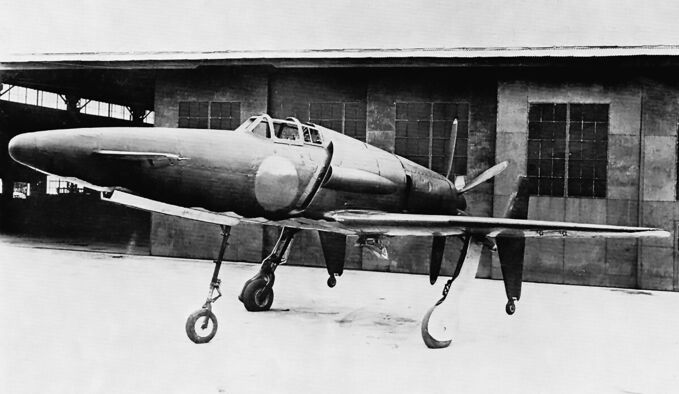The Kyushu J7W1 Shinden (meaning "Magnificent Lightning") was the only canard-configured aircraft ordered for mass production during World War II, and it was one of the most unique aircraft designs to come out of Japan. The concept for this distinctive configuration originated with Captain Masaoki Tsuruno of the Japanese Navy's Technical Staff. Captain Tsuruno envisioned replacing the rear-mounted radial engine driving a six-blade propeller with a turbojet engine.
To explore the feasibility of this idea, the Dai-Ichi Kaigun Koku Gijitsusho (First Naval Air Technical Arsenal) took up Tsuruno's concept. They designed a glider, the MXY6, to test the handling characteristics of the proposed aircraft at low speeds.
- A total of three prototypes of the MXY6 were constructed by Chigasaki Seizo K.K. for the Navy.
These all-wood gliders featured moderately swept wings and tall tail surfaces located inboard of the ailerons, and they began flight testing to assess the design's aerodynamic qualities.
The successful testing of these gliders contributed to the development of the J7W1, which would go on to become one of the most radical and unusual designs in aviation history.
Trial
The trials of the MXY6 gliders in the autumn of 1943 demonstrated the feasibility of the canard configuration for a high-performance aircraft. Later one of these aircraft was experimentally fitted with a 22 hp Semi 11 ([Ha-90] 11) four-cylinder air-cooled engine.
Based on these successful trials, the Japanese Navy decided to move forward with designing a Type Otsu (B) Interceptor Fighter that would adopt this innovative configuration. The task was assigned to Kyushu Hikoki K.K., despite their lack of experience with high-performance aircraft.
This decision was made because Kyushu's design team and production facilities were relatively unburdened compared to other manufacturers, and the Navy decided to reinforce their capabilities by assigning a team from the Dai-Ichi Kaigun Koku Gijitsusho, led by Captain Tsuruno, to assist with the project.
Construction J7W1
Work on the J7W1 Shinden began in earnest in June 1944, and impressively, the first prototype was completed within just ten months. The aircraft featured a distinctive design where the nose, which housed the horizontal control surfaces with elevators, contained four 30 mm Type 5 cannon. The nose also accommodated the nosewheel for landing and takeoff operations.
The pilot was seated in the center of the fuselage, ahead of the aft-mounted swept wings. The main undercarriage legs and wheels retracted laterally into the wings, and small auxiliary wheels retracted into the base of the two vertical fins and rudders that were attached to the wings.
This innovative design marked the Shinden as a highly unconventional aircraft, characterized by its distinctive canard configuration and focus on firepower, maneuverability, and speed.
Engine
The J7W1 Shinden was powered by the Mitsubishi MK9D ([Ha-43] 12) eighteen-cylinder radial engine, rated at 2,130 hp, which was installed behind the pilot's cockpit.
This engine drove a six-blade pusher propeller via an extension shaft. The engine's cooling system used long, narrow, obliquely mounted intakes on either side of the fuselage, a design that aimed to meet the aircraft's high-performance needs.
Recognizing the importance of this heavily armed high-performance interceptor, the Japanese Navy ordered the J7W1 into production at Kyushu's Zasshonokuma factory and Nakajima's Handa plant even before its first flight.
Given the strained conditions of the Japanese aircraft industry at the time, the Navy's ambitious production goal of 30 Shindens per month at Zasshonokuma and 120 at Handa was over-optimistic. Unfortunately, Japan's surrender ended these plans before they could be realized.
First flight
The first flight of the J7W1 was delayed due to issues with engine cooling and the unavailability of certain equipment. Despite these setbacks, the aircraft was eventually flown for the first time on 3 August 1945 by Captain Tsuruno at Fukuoka Airport. This flight was brief, lasting only about 45 minutes in total across three short flights. During these flights, several issues were identified, including a strong torque pull to starboard on takeoff and propeller vibrations caused by the extended drive shaft.
By the end of the war, a second prototype of the J7W1 was completed but had not yet flown. This aircraft was eventually dismantled and shipped to the United States for evaluation. Additionally, plans for a J7W2 version were in place, which would have replaced the radial engine with a 900 kg Ne-130 turbojet, marking a significant step toward jet propulsion for the Shinden. However, these developments were halted by the war's end.
- https://oldmachinepress.com/2020/05/20/kyushu-j7w1-shinden-interceptor-fighter/
- https://www.amazon.com/Japanese-Aircraft-Pacific-Rene-Francillon/dp/0370000331
- Green, William (1973) [1961]. War Planes of the Second World War. v. 3 (seventh impression ed.). London: Macdonald & Co. ISBN 0-356-01447-9.
- "幻の戦闘機「震電」のレプリカ 福岡・筑前町の大刀洗平和記念館に" [Replica of the mythical fighter jet "Shinden" at Tachiarai Peace Memorial Museum in Chikuzen, Fukuoka]. 朝日新聞デジタル (in Japanese). 2022-07-07. Retrieved 2022-09-13.
- https://books.google.nl/books?id=KR5xDwAAQBAJ&pg=PA127&redir_esc=y#v=onepage&q&f=false
- Chambers, Mark (29 November 2018). Wings of the Rising Sun: Uncovering the Secrets of Japanese Fighters and Bombers of World War II. Bloomsbury. ISBN978-1-4728-2371-7.
- Goodwin, M. (2017). Japanese Aero-Engines 1910-1945. Mushroom Model Publications.
- https://books.google.nl/books?id=umRPvgAACAAJ&hl
- Francillon, René J. Japanese Aircraft of the Pacific War. London: Putnam & Company, 1970 (2nd edition 1979). ISBN 978-0-370-30251-5.
For pictures:
- https://en.wikipedia.org/wiki/Kyushu_J7W_Shinden
- Chambers, Mark (29 November 2018). Wings of the Rising Sun: Uncovering the Secrets of Japanese Fighters and Bombers of World War II. Bloomsbury. ISBN978-1-4728-2371-7.










